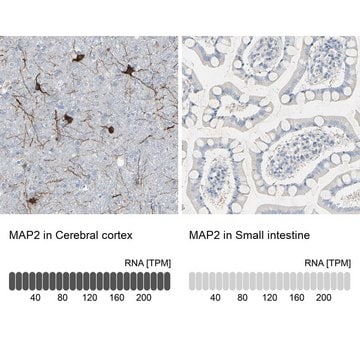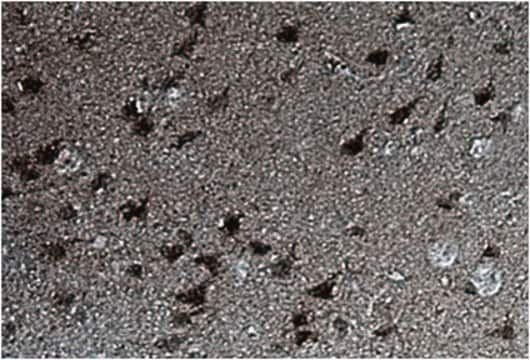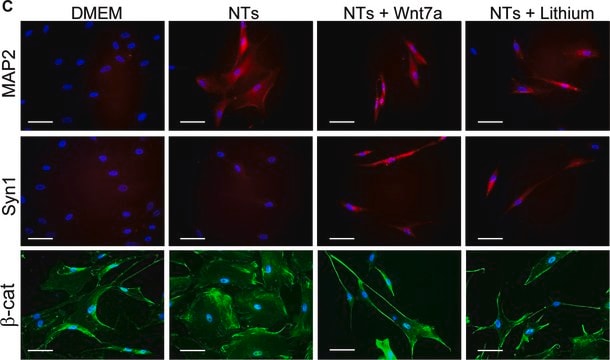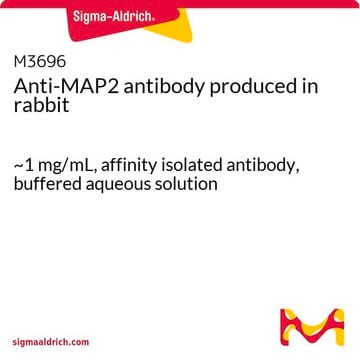MAB3418
Anti-MAP2 Antibody, clone AP20
clone AP20, Chemicon®, from mouse
Synonyme(s) :
Microtubule Associated Protein, MAP2A and 2B
About This Item
Produits recommandés
Source biologique
mouse
Niveau de qualité
Forme d'anticorps
purified immunoglobulin
Type de produit anticorps
primary antibodies
Clone
AP20, monoclonal
Espèces réactives
bovine, mouse, rat, chicken, quail, Xenopus, human
Conditionnement
antibody small pack of 25 μg
Fabricant/nom de marque
Chemicon®
Technique(s)
immunohistochemistry: suitable
western blot: suitable
Isotype
IgG
Numéro d'accès NCBI
Numéro d'accès UniProt
Conditions d'expédition
ambient
Température de stockage
2-8°C
Modification post-traductionnelle de la cible
unmodified
Informations sur le gène
chicken ... Map2(424001)
frog ... Map2(780043)
human ... MAP2(4133)
mouse ... Map2(17756) , Map2(281294)
rat ... Map2(25595)
Description générale
Spécificité
Immunogène
Application
Neuroscience
Neuronal & Glial Markers
60 ng/mL. In SDS-PAGE, MAP-2 from adult rat migrates as a closely associated doublet having a molecular weight of approximately 280-300 kD representing the MAP-2A and -2B isoforms but not the 70 kDa MAP-2C isoform. However, early in brain development (postnatal day 10 in rats), MAP-2 migrates as a single band that is identical to the lower molecular weight band of the adult MAP-2 doublet (MAP-2b). Later in development (postnatal days 17-18), the mobility of MAP-2 changes to the adult doublet form. (In the spinal cord, conversion to the adult form occurs earlier). Users should run 4%-20% SDS-PAGE gradient gels.
Immunohistochemistry:
5 µg/mL (4% PFA fixed frozen sections).
Immunohistochemistry:
5 µg/mL of a previous lot was used. Anti-MAP-2 can be used to stain tissue (brain or spinal cord) fixed with paraformaldehyde.
Optimal working concentrations must be determined by the end user.
Qualité
Western Blot Analysis:
1:1000 dilution of this lot detected MAP2 on 10 μg of Rat Brain lysate.
Description de la cible
Forme physique
Stockage et stabilité
During shipment, small volumes of product will occasionally become entrapped in the seal of the product vial. For products with volumes of 200 µL or less, we recommend gently tapping the vial on a hard surface or briefly centrifuging the vial in a tabletop centrifuge to dislodge any liquid in the container’s cap.
Remarque sur l'analyse
Brain, Neuronal culture, Human glioblastoma T98G cells.
Autres remarques
Informations légales
Clause de non-responsabilité
Not finding the right product?
Try our Outil de sélection de produits.
En option
Code de la classe de stockage
12 - Non Combustible Liquids
Classe de danger pour l'eau (WGK)
WGK 1
Point d'éclair (°F)
Not applicable
Point d'éclair (°C)
Not applicable
Certificats d'analyse (COA)
Recherchez un Certificats d'analyse (COA) en saisissant le numéro de lot du produit. Les numéros de lot figurent sur l'étiquette du produit après les mots "Lot" ou "Batch".
Déjà en possession de ce produit ?
Retrouvez la documentation relative aux produits que vous avez récemment achetés dans la Bibliothèque de documents.
Les clients ont également consulté
Articles
Human iPSC neural differentiation media and protocols used to generate neural stem cells, neurons and glial cell types.
Notre équipe de scientifiques dispose d'une expérience dans tous les secteurs de la recherche, notamment en sciences de la vie, science des matériaux, synthèse chimique, chromatographie, analyse et dans de nombreux autres domaines..
Contacter notre Service technique
















